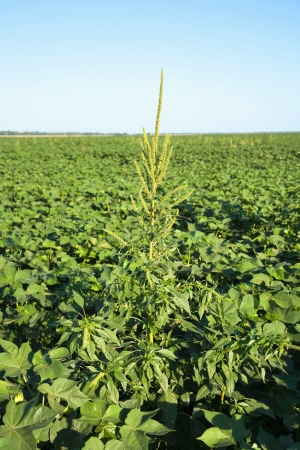 War on weeds loses ground
War on weeds loses ground
The rise of herbicide-resistant varieties drives a search for fresh methods of control.
Standing tall: glyphosate-resistant pigweed growing in Roundup Ready cotton.
Bill Barksdale/AgStock Images/Corbis
With its jumble of leaves and pointy, green, flower spikes, the plant known as pigweed or palmer amaranth (Amaranthus palmeri)
isn’t much to look at. But to farmers in the southeastern United
States, it is a formidable foe. Having evolved the ability to withstand
glyphosate, the main ingredient in Monsanto’s popular herbicide Roundup,
it now flourishes unchecked alongside crops such as cotton and soya
bean that are genetically modified to be glyphosate tolerant.
And it is not unique, says agronomist Harold Coble at the
Office of Pest Management Policy in Raleigh, North Carolina, part of the
US Department of Agriculture (USDA), who notes that 383 known weed
varieties have the genetic defences to survive one or more herbicides.
“Weed resistance is a game changer for agriculture in the same way that
drug resistance has been a game changer for the health-care industry,”
says Coble, who spoke on 10 May at a Weed Summit in Washington DC
convened by the National Academies. The problem has escalated since the
widespread introduction of Roundup Ready and similar crops over the past
decade allowed farmers to apply glyphosate more liberally. At the
summit, distinctly different responses to the challenge were up for
discussion.
The conventional approach is to switch to a different
herbicide and engineer crops to withstand it. This has produced a wave
of genetically modified crops under review by the USDA, which earlier
this year made changes to speed up its approval process. Next to receive
a green light could be maize (corn) that is tolerant to glyphosphate
and 2,4-dichlorophenoxyacetic acid (2,4-D). Created by Dow AgroScience
in Indianapolis, Indiana, the plants can break down both of the
chemicals in Dow’s newly formulated herbicide Enlist. “You’re applying
two different ways of killing the weed at the same time,” says Mark
Peterson, global biology team leader at Dow. “The odds that you’re going
to have a weed that’s resistant to both are very low.”
Environmental groups oppose Dow’s application, which drew
more 365,000 public comments last month. News reports have drawn
attention to the fact that 2,4-D was one of the ingredients (although
not the most toxic) in the defoliant Agent Orange, used during the
Vietnam War.
Researchers
are also wary of engaging in a continuing arms race with nature. “A
number of analysts feel that such an approach is short sighted and
doomed to fail,” says agronomist Matt Liebman of Iowa State University
in Ames. The chief worry is that new herbicide blends will accelerate
the emergence of resistance to multiple chemicals. In a paper published
in January, weed ecologist David Mortensen of Pennsylvania State
University in University Park and his colleagues argue that the growing
number of multiresistant weed varieties proves that “weeds can defy the
probabilities” (D. A. Mortensen et al. BioScience 62, 75–84; 2012).
Mortensen expects that increased reliance on two herbicides will favour
plants with multiple mutations for resistance to each, as well as the
emergence of plants with more general survival strategies, such as the
ability to break up certain molecular structures or to confine
herbicides in cell vacuoles. “These are traits that could overcome more
than one chemical mode of action and see an increase in selection
pressure,” says Mortensen.
How much of an increase depends on how widely the
multitolerant crops are planted and how frequently the herbicide
combinations are used. Although Dow will include a set of recommended
management practices with its products, “there are no enforcement
regulations”, says Carol Mallory-Smith, a weed scientist at Oregon State
University in Corvallis. The threat of multiresistance has prompted a
return to older methods of weed control. Stanley Culpepper, a weed
scientist at the University of Georgia in Tifton, has shown that
planting a cover crop of rye blocks sunlight and reduces the number of
pigweed seeds that germinate by 75%. In Georgia and elsewhere, Culpepper
says, herbicide resistance is already forcing farmers to combine such
techniques with conventional herbicide use.
New machinery could also help. At the weed summit,
agronomist Michael Walsh of the University of Western Australia in
Crawley described the Harrington Seed Destructor, a harvester that
collects weed seeds along with the crop, smashes up about 95% of them,
and sprinkles the harmless remains in its wake.
“The weeds that have survived the crop season are the ones
that are the most likely to have stacked resistance because they’ve
survived herbicide applications, so that’s why we’re pushing these
harvesting techniques,” says Walsh.
And then there are biocides. The USDA and the agrochemical
industry are looking into the use of the natural chemical defences of
plants and microbes to control weeds. On 17 May, the US Environmental
Protection Agency approved a bioherbicide from Marrone Bio Innovations
in Davis, California. Its primary component is derived from the soil
bacterium Streptomyces and disrupts weed-cell division. Such solutions may be easier on the environment but if overused could still breed resistance.
Most agree that farming in a post-Roundup era will be more
complicated. “The reality of weed management without the silver bullet
of glyphosate is that we need to revert to a many-hammers approach —
crop rotations, cultivations, tillage, appropriate herbicide
application,” says agronomist Charles Benbrook, a research professor at
Washington State University’s Center for Sustaining Agriculture and
Natural Resources in Puyallup. “It’s going to take more time, it will
take more management care, and it will probably cost more money.”
- Nature 485, 430 ()
SOURCE: http://www.nature.com/news/war-on-weeds-loses-ground-1.10691
No comments:
Post a Comment